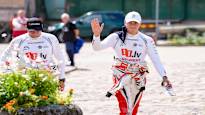Urheilu’s rally expert Henri Haapamäki believes that Martins Sesks’ example can encourage the background forces of other young promises to make similar investments.
Urheilu’s rally editor Micke Suopuro and expert Henri Haapamäki packed the topics of the World Rally Championship in Latvia. You can listen to the discussion on the player below or on Areena by following this link.
When the World Rally Championship in April announced that the Latvian Martin Sesks would compete with rally1 equipment in Poland and Latvia, the information did not arouse great expectations.
In recent years, several drivers have tried their wings in the World Championship with the support of their own partners as well as the motor sports associations of individual countries. Names like Pierre-Louis Loubet, Gus Greensmith and the series with the rally1 fleet currently touring Gregoire Munster, have only been able to make single points in the main class, despite several competitions or even seasons.
Flashing with the tactic of one display location has been tried in recent years, for example Jari Huttunen and Neil Solans. For Huttunen, the risk backfired: the screening location for the summer 2022 Jyväskylä World Rally Championship was ruined due to Ford’s technical problems.
The risks are significant in a single investment of hundreds of thousands of euros, especially when it has been said in the big picture that you can’t drive peak times unless you first gain experience.
Before the Rally Poland, Martins Sesks had not driven a single race at the World Championship level, not even in a rally2 car. Last year, of course, the Latvian won two rallies in the EC series.
And what happened at the World Championship level with the top class car? In Poland, Sesks finished fifth in the overall competition, even though he still drove in the rally without a hybrid unit. In front of the home crowd in Latvia, he reached two bottom times, was on the podium before the final stretch and collected the fourth highest points.
– Dazzling and mature execution. Of course, he knew the roads, but not everyone can drive at that speed, even if they know the tricks in their dreams, Urheilu’s expert Henri Haapamäki resemble.
The success of sex can at best have consequences that shake the whole sport.
Belief in taking a big risk may increase
On both sides of the turn of the millennium, it was common for aspiring drivers to try to show in individual races. For example, the starting lists of the Jyväskylä World Rally Championship could be full of Finnish private drivers who tried to break through with equipment suitable for the main class.
During the last decade, the trend changed. The more expensive it has become to participate in a single competition, the fewer entrepreneurs there have been. The risks have grown larger than the possible returns.
It has been more reasonable to allocate the subsidy euros to the WRC2 class driven by cheaper rally2 cars and the rally EC series. For the price of a single rally1 race, it is possible to gain experience from several different World Cup rallies.
– For a long time, it has been a bit forgotten that first-class cars could try to give displays in individual races. Those devices have been considered so utopian. Now it has been proven how even with a little experience you can achieve top results. It’s great for the sport as a whole, Haapamäki explains.
In Haapamäki’s opinion, Sesks’ example can inspire supporters who believe in young promises to also invest in individual rally1 competitions in the future.
– In the background, it may flash that if the driver we support would be the next one. This way you can get excited about stacking packages. Of course, results cannot be achieved without an extremely talented driver, says Haapamäki.
What can you expect from Sami Pajar in his first class debut?
When Sami Pajari won the Junior World Championship in 2021, Martins Sesks finished third in the same series.
After the title, Pajar’s career has been built wisely step by step. This season, Pajari has risen to fight for the WRC2 class championship.
Now Sesks has risen from Pajar’s shadow to the spotlight in an instant. However, the Finn has a chance to do the same next week in Jyväskylä.
Pajar’s task is challenging. You can hardly expect “even” bottom time in the home rally from him. Pajari certainly knows many of Jyväskylä’s special tests, but the roads are also familiar to others. Sesks was able to enjoy the home field advantage in Latvia, because the other top drivers had little experience in the rally.
Still, Sesksi’s example raises expectations for Pajar as well: as a debutant, you can succeed in flashing, even if you are not Kalle Rovanperän like the talent of the century.
– It would not be impossible to think that Pajari would be able to drive good results right away, considering his current level of performance. Maintaining the pace for days is then more difficult, says Haapamäki.
– Pajari has had a strong Toyota stamp for a long time. It was hardly the first time we were behind the wheel of a rally1-Toyota until the tests in Jyväskylä, Haapamäki continues.
